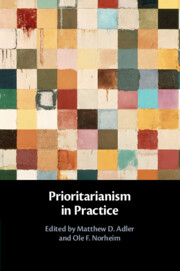Book contents
- Prioritarianism in Practice
- Prioritarianism in Practice
- Copyright page
- Contents
- Figures
- Tables
- List of Contributors
- 1 Introduction
- 2 Theory of Prioritarianism
- 3 Well-Being Measurement
- 4 Prioritarianism and Optimal Taxation
- 5 Prioritarianism and Measuring Social Progress
- 6 Prioritarianism and Health Policy
- 7 Prioritarianism and Fatality Risk Regulation
- 8 Prioritarianism and Climate Change
- 9 Prioritarianism and Education
- 10 Empirical Research on Ethical Preferences: How Popular is Prioritarianism?
- 11 Prioritarianism and Equality of Opportunity
- 12 Prioritarianism and the COVID-19 Pandemic
- Index
- References
6 - Prioritarianism and Health Policy
Published online by Cambridge University Press: 09 June 2022
- Prioritarianism in Practice
- Prioritarianism in Practice
- Copyright page
- Contents
- Figures
- Tables
- List of Contributors
- 1 Introduction
- 2 Theory of Prioritarianism
- 3 Well-Being Measurement
- 4 Prioritarianism and Optimal Taxation
- 5 Prioritarianism and Measuring Social Progress
- 6 Prioritarianism and Health Policy
- 7 Prioritarianism and Fatality Risk Regulation
- 8 Prioritarianism and Climate Change
- 9 Prioritarianism and Education
- 10 Empirical Research on Ethical Preferences: How Popular is Prioritarianism?
- 11 Prioritarianism and Equality of Opportunity
- 12 Prioritarianism and the COVID-19 Pandemic
- Index
- References
Summary
This chapter aims to present a practical prioritarian approach to economic evaluation of health programmes, taking into account impacts on income as well as health, with an illustrative application. We propose applying the prioritarian transform to lifetime well-being, defined as the sum of current period well-being over the lifetime. We first describe two simple ways of combining individual-level information on income and health to generate an index of well-being, based on the equivalent life and equivalent income approaches respectively. We then illustrate how these two metrics can be used to conduct lifetime prioritarian evaluation using a simple hypothetical comparison of two funding options for cancer treatment in a low-income country – out-of-pocket payment (OOP) and universal public funding (UPF) via taxes or compulsory insurance premiums proportional to income. We compare the findings of lifetime prioritarian evaluation with those of utilitarian evaluation and benefit-cost analysis.We find that standard cost-effectiveness analysis and benefit-cost analysis are not sensitive to income redistribution, while lifetime prioritarian evaluation is sensitive not only to total effects on health and income but also to progressive redistribution of lifetime income, health and well-being favouring the worse-off.
Keywords
- Type
- Chapter
- Information
- Prioritarianism in Practice , pp. 260 - 316Publisher: Cambridge University PressPrint publication year: 2022
References
- 3
- Cited by

